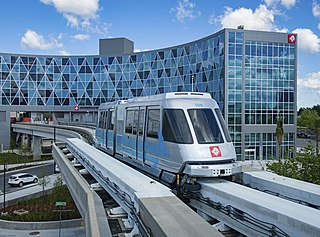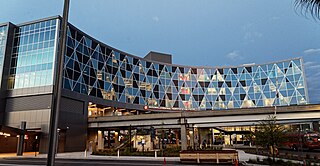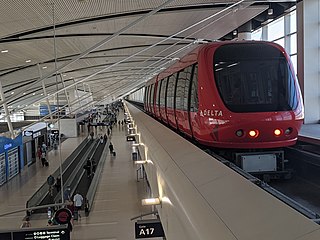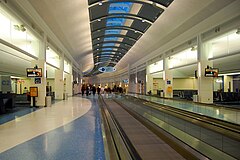
A people mover or automated people mover (APM) is a type of small scale automated guideway transit system. The term is generally used only to describe systems serving relatively small areas such as airports, downtown districts or theme parks.

Jacksonville International Airport is a civil-military public airport 13 miles (21 km) north of Downtown Jacksonville, in Duval County, Florida. It is owned and operated by the Jacksonville Aviation Authority.

The Jacksonville Skyway is an automated people mover in Jacksonville, Florida. It opened in 1989 and is operated by the Jacksonville Transportation Authority (JTA). The skyway has three stations in Downtown Jacksonville and was extended in 1996 following a conversion from its original technology to Bombardier Transportation equipment. It was expanded again in 1998 and 2000. The currently fare-free system comprises two routes across 2.5 miles (4.0 km) of track, serving eight stations, and crosses the St. Johns River on the Acosta Bridge. In 2023, the system had a ridership of 309,000, or about 1,200 per day as of the third quarter of 2024.

The Jacksonville Transportation Authority (JTA) is the independent agency responsible for public transit in the city of Jacksonville, Florida, and roadway infrastructure that connects northeast Florida. However, they do not maintain any roadways. In 2023, the system had a ridership of 6,687,200, or about 24,600 per weekday as of the third quarter of 2024.

Transportation in Philadelphia involves the various modes of transport within the city and its required infrastructure. In addition to facilitating intracity travel, Philadelphia's transportation system connects Philadelphia to towns of its metropolitan area and surrounding areas within the Northeast megalopolis.

Rosa Parks Transit Station is an intermodal transit station in Downtown Jacksonville, Florida. It is operated by the Jacksonville Transportation Authority (JTA) as a station for the Jacksonville Skyway elevated people mover. It previously served as Jacksonville's main city bus station before being replaced by the Jacksonville Regional Transportation Center at LaVilla in May 2020. It is located on Hogan Street between State Street and Union Street, and is the Skyway's northern terminus. It is across the street from the Downtown campus of Florida State College at Jacksonville.

The Jacksonville Regional Transportation Center at LaVilla(JRTC) is an intermodal transit station in Jacksonville, Florida. It serves the Jacksonville Transportation Authority (JTA) bus system, the First Coast Flyer bus rapid transit (BRT) system, and the Jacksonville Skyway monorail, as well as home to JTA's administrative offices.

The Jacksonville Metropolitan Area, also called the First Coast, Metro Jacksonville, or Northeast Florida, is the metropolitan area centered on the principal city of Jacksonville, Florida and including the First Coast of North Florida. As of the 2020 census, the total population was 1,605,848. The Jacksonville–Kingsland–Palatka, FL–GA Combined Statistical Area (CSA) had a population of 1,733,937 in 2020 and was the 34th largest CSA in the United States. The Jacksonville metropolitan area is the 40th largest in the country and the fourth largest in the State of Florida, behind the Miami, Tampa, and Orlando metropolitan areas.

The Port of Jacksonville (JAXPORT) is an international trade port on the St. Johns River in Jacksonville, Florida. JAXPORT is the largest port by volume in Florida, and the 14th largest container port in the United States. It carries about 18 million short tons of cargo each year and has an annual economic impact of over $31 billion, including 138,500 jobs across the state of Florida related to cargo moving through the port. It handled 1,338,000 containers, and is the second largest handler of vehicles in the United States with 696,500 in 2019.
Transportation in Erie, Pennsylvania includes access to most major forms of transportation, including automobile, bus, train, taxi, airplane, and ship. The city generates income through the transportation industry, including train manufacturing and port operations.
Transportation in Florida includes a variety of options, including Interstate Highways, U.S. Highways, and Florida State Roads; Amtrak and commuter rail services; airports, public transportation, and sea ports, in a number of the state's counties and regions.
The transportation system of Georgia is a cooperation of complex systems of infrastructure comprising over 1,200 miles (1,900 km) of interstates and more than 120 airports and airbases serving a regional population of 59,425 people.

Transportation in Indianapolis consists of a complex network that includes a local public bus system, several private intercity bus providers, Amtrak passenger rail service, four freight rail lines, an Interstate Highway System, an airport, a heliport, bikeshare system, 115 miles (185 km) of bike lanes, and 116 miles (187 km) of trails and greenways. The city has also become known for its prevalence of electric scooters.

Transportation in metropolitan Detroit comprises an expansive system of roadways, multiple public transit systems, a major international airport, freight railroads, and ports. Located on the Detroit River along the Great Lakes Waterway, Detroit is a significant city in international trade, with two land crossings to Canada. Three primary Interstate highways serve the region.
There are many different types of transportation in North Carolina, including air, rail, mass transit, and major highways. North Carolina is a rapidly growing state with over 10.4 million people and requires multiple types of transportation. Currently, NC has 10 commercial and many municipal airports, a passenger rail called NC By Train operated by North Carolina in partnership with Amtrak with many different routes, public bus transportation in cities like Raleigh and Charlotte, and highways that span the State.
Transportation in the Las Vegas Valley including the Nevada cities of Las Vegas, North Las Vegas and Henderson is a multi-faceted system. The street system is mostly laid out in a north–south/east–west system of roads. While most residents rely on cars, there is a network of bus routes reaching some areas of the county. The Las Vegas Valley, being the one of the largest tourist destinations in the world, has a mass transportation system which favors the Las Vegas Strip.

The Northside is a large region of Jacksonville, Florida, and is generally understood as a counterpart to the city's other large regions, the Urban Core, Arlington, Southside, Westside, and the Beaches. The expansive area consists of historic communities, cultural landmarks, protected ecosystems and vital transportation and logistics facilities, all fundamental to the history and development of Jacksonville.
The First Coast Flyer is a bus rapid transit (BRT) system in Jacksonville, Florida, owned and operated by the Jacksonville Transportation Authority (JTA). It currently consists of four radial routes running north, southwest, southeast, and east from the Jacksonville Regional Transportation Center in Downtown Jacksonville, where it connects to the Jacksonville Skyway. The first phase, including stations in Downtown Jacksonville and the northbound Green Line, opened in December 2015, with the southbound Blue Line opening in 2016. Additional phases, including the eastbound Red Line and southwestern Orange Line opened in 2018 and 2021, respectively.

The Tampa International Airport People Movers are a set of automated people mover systems operating within Tampa International Airport. The primary set of people movers are automated guideway transit (AGT) systems that connect the airport's main terminal to four satellite airside concourses. Opened in 1971, the landside/airside shuttles were the first people movers used to transport passengers within an airport terminal. A fifth people mover line known as SkyConnect, which began operating in 2018, connects the main terminal with the airport's economy parking garage and rental car center. In addition, a monorail once connected the main terminal and the long-term parking garage from 1991 until its closure in 2020.

The transportation system of Cleveland is a network that includes several modes of transportation including sidewalks, roads, public transit, bicycle paths and regional and international airports.





















